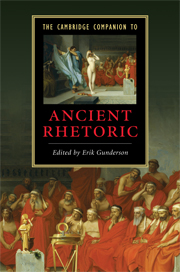Introduction
Published online by Cambridge University Press: 28 January 2010
Summary
“First and foremost: what is rhetoric?” (Quintilian, Institutes 2.15.1)
Barring failures of reasoning, conclusions flow more or less inevitably from premises. The choice of a definition of rhetoric is accordingly a decisive moment for any account of rhetoric. Aristotle immediately follows his propositions concerning the role of definitions by enjoining a definition of his own: “Let rhetoric be the capacity to discover the possible means of persuasion concerning any subject. However, the number of available definitions of rhetoric embarrasses in more than one sense. On the one hand it is clear that Aristotle’s account of rhetoric is itself reacting to other contemporary competing accounts. And, on the other hand, Aristotle’s definition is not the last one that will be offered. For example, Quintilian chooses, “Knowing how to speak well.” Quintilian’s definition itself comes after a long and detailed discussion of the variety of other available definitions, including Aristotle’s.
Post-classical thought also offers its own modifications of these ancient positions as well as some novelties. Kant yokes rhetoric and poetry when describing the arts of speech: “The rhetorical arts are oratory and poetry.” He goes on to define rhetoric as “the art of carrying on a serious business of the understanding as if it were a free play of the imagination” and poetry as “the art of conducting a free play of the imagination as if it were a serious business of the understanding.”
- Type
- Chapter
- Information
- The Cambridge Companion to Ancient Rhetoric , pp. 1 - 24Publisher: Cambridge University PressPrint publication year: 2009
- 1
- Cited by

